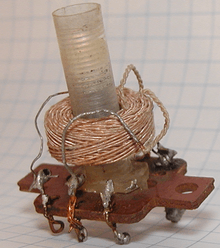Basket winding

Basket winding (or basket-weave winding or honeycomb winding) is a pattern of winding electrical wire in a coil, used in making certain types of electronic components, such as inductors and transformers. The purpose of this type of winding is to minimize having adjacent turns of wire running parallel. In a basket winding the wires in successive layers of the coil cross each other at large angles, as close to 90 degrees as possible. Basket winding is employed in inductors for use at high frequencies, above 50 kHz, because it reduces energy losses. However, the physical dimensions of the coil are increased, which results in higher leakage inductance.
Basket windings are used because they reduce losses due to two undesirable side effects that occur in coils at radio frequencies: proximity effect and parasitic capacitance. At high frequencies, the effect of the magnetic field of nearby parallel turns of wire causes the current in each wire to be concentrated in a small region at the surface of the wire, next to the adjacent wires; this is proximity effect. It increases the resistance of the wire, resulting in energy losses. In tuned circuits, the increased resistance of the inductor can reduce the Q factor of the circuit, increasing the bandwidth. In addition, the parallel turns of wire act as capacitor plates, storing charge; this is parasitic capacitance. The parasitic capacitance can cause the coil to become self-resonant at high frequencies. Basket wound coils, having fewer sections of wire lying parallel, have less parasitic capacitance and proximity effect, and so are used in radio equipment, such as radio receivers.
Basket windings are often wound with Litz wire, a multistrand wire with each strand individually insulated, which further reduces losses. Cotton or fabric insulation is important from a mechanical point of view during the winding process, because a common enamelled magnet wire would not provide sufficient surface friction between the layers to hold subsequent turns at the large angle.[1]
